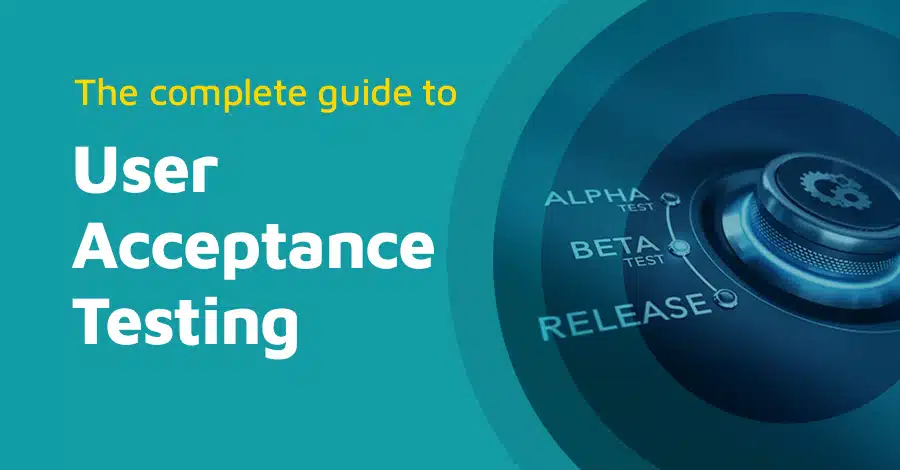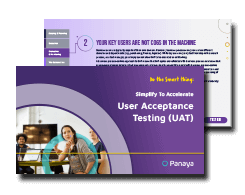Table of Content
UAT, short for User Acceptance Testing, is the final and most crucial stage in the software development lifecycle. In this phase, real end-users test the software in real-world conditions to verify that it meets all business requirements before going live. Unlike system or integration testing, UAT focuses on validating end-to-end business flows, ensuring the software not only works, but works for your people, processes, and goals.
What is UAT Testing? User Acceptance Testing Full Form & Meaning
The full form of UAT is User Acceptance Testing. It is sometimes referred to as application testing or end-user testing.
The main goal is to confirm that the software behaves exactly as intended in actual business scenarios before it’s deployed into production. This stage comes after unit testing, integration testing, and system testing have been completed.
During UAT:
- Actual business users – not just QA testers – execute test cases.
- Testing happens in a separate UAT environment.
- Results are evaluated against business acceptance criteria.
- Final sign-off determines if the software is ready for go-live.
Skipping or rushing UAT can result in costly fixes, reduced user adoption, and damaged trust in the solution.
What You Will Learn
- The UAT full form and why it matters in software delivery.
- How to run the UAT testing process step-by-step.
- Key prerequisites for successful user acceptance testing.
- The most common challenges and how to solve them.
- How Panaya Test Dynamix makes UAT faster, easier, and risk-free.
UAT Testing Process: How to Perform User Acceptance Testing Step-by-Step
1. Prepare UAT Test Scenarios & Cases
Define clear test scenarios based on business requirements, covering critical end-to-end flows.
2. Identify Suitable Participants
Select real users who understand the business processes, not only IT testers.
3. Set Up a Dedicated UAT Environment
Keep it separate from development and production to avoid data conflicts.
4. Provide Instructions & Access
Train participants, share testing guidelines, and ensure they can log issues easily.
5. Automate Scheduled Tasks
Automated reminders, scheduled steps and clear objectives help dramatically reduce cycle times.
6. Execute Test Cases
Users perform tests, document results, and flag any defects.
7. Review & Fix Issues
Developers resolve defects, and testers retest before final sign-off.
8. Approve & Go Live
Once acceptance criteria are met, UAT sign-off confirms the product is ready.
With Panaya Test Dynamix, UAT test cases, documentation, defect tracking, and notifications are automated – cutting UAT time by up to 50% and eliminating Excel chaos.
UAT Prerequisites: What You Need Before Beginning with User Acceptance Testing
Before you start UAT, ensure these prerequisites are in place to avoid wasted time and incomplete results:
- Clear business requirements were shared with the testing team.
- Completion of system, integration, and regression testing with no critical defects.
- A ready-to-use UAT environment with test data prepared.
- Defined acceptance criteria for pass/fail outcomes.
- Available business users are committed to testing within the timeline.
Without these, UAT risks becoming slow, inconsistent, and inconclusive.
UAT Testing Challenges and How to Overcome Them
User Acceptance Testing (UAT) presents several challenges that organizations must address to achieve a successful testing outcome. One significant challenge is the potential damage to reputation caused by rework and retesting. If organizations continue to rely on outdated tools like Excel or traditional test management tools, it can lead to difficulties coordinating with business users and lack of visibility into the testing status. Besides, coordinating with globally dispersed business users can become costly and time-consuming. Other common UAT challenges include engaging non-technical business users, facilitating collaboration between users, reducing idle time, improving visibility and control over the testing process, and ensuring high-quality test evidence without disrupting user productivity, increasing location costs, or interfering with business users’ availability.

UAT Testing Best Practices & Checklist
The key to successful UAT is adopting industry best practices, including five steps that take you through the process from start to finish.
1. Knowledge Gathering for Test Planning
Always begin by gathering the information required to create a comprehensive test. Your list of questions for the relevant stakeholders must include:
- Which business processes should be tested?
- What sequence of actions must be taken for a representative test?
- What are the guidelines for selecting test data?
- What are the intended results of the changes made?
- Which UAT team is responsible for testing?
Generally, the entire process requires a significant degree of collaboration between the integration manager, the different functional leads, and the relevant business process owners.
2. UAT Scoping
Not all business processes must be tested. Some can be safely ignored. It would be best if you never began UAT until you’ve defined the scope of your project. You’ll find that it tends to balloon pretty quickly. Unless you scope in advance, it can become challenging to decide on the fly what is critical for the success of your test.
3. UAT Design
Once you understand the scope of your UAT test, you can move on to design. This includes mapping and assigning different steps to various business users and setting a timeline. As time passes and you have more use cases to reference, this step will become much more manageable.
4. UAT Execution
With your UAT process clearly defined, you can now begin testing, address any defects and decide if you should move ahead to production or not. To make this step optimally efficient, you’ll need flawless communication and balance between testers and developers, focusing on documentation (see below for a deeper dive into this issue), progress reporting, and defect management.
5. Business Objective Confirmation
Once execution is over, and as many defects as possible are resolved, it is time to sign off on UAT and go live. The sign-off approval indicates that the change meets business requirements and is ready for deployment.
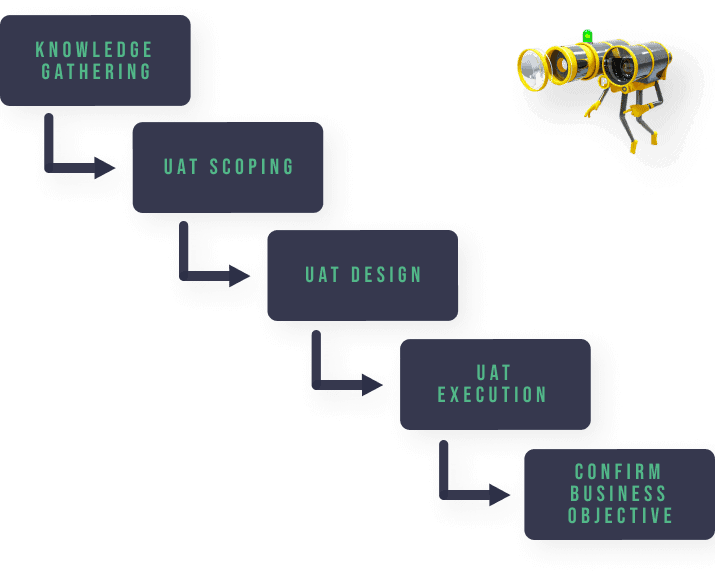
The Importance of UAT Documentation
Documentation of your UAT testing strategy and the overall plan is indispensable to the outcome of your current and future tests. This documentation should include information about out-of-scope situations that are worth testing, the expectations for the test, general agreements about the standards for passing, how to carry out the test, the owners and participants involved, the scope of work, and the venue used. Additionally, it’s important to note any successful past use cases, including details about the test structures, management, and outcomes. This documentation will provide a clear and comprehensive guide for the entire testing process.
UAT Test Case Outcomes
Document your tests and their results with traceable and annotated records that are easy to access and use. (But please don’t mistake Excel sheets for ‘easy to use’.) Here are some examples of the kinds of data to include in your outcome documentation:
- Acceptance criteria
- Business impact (e.g., high, medium, low)
- Business requirement
- Comments
- Date executed
- Expected outcomes
- Name of tester
- Pass/Fail
- Test case name and number
- Test case steps defined
Your testers should independently record their own UAT results, which should be reviewed daily. In this way, issues can be identified early and addressed immediately.
How to Make Your UAT Even More Effective
With the right agile UAT tools in place, you can tackle those challenges and take the best practices we talked about to the next level. You’ll be reducing the time and effort needed for UAT processes by up to 50%.
Plan Right
Engaging both your functional and business users on a standardized platform from the start is key to ensuring tests reflect actual end-to-end business processes. The right solution will offer collaborative technologies to coordinate among cross-functional, globally-dispersed users, and will be intuitive enough to ensure business users are comfortable with the process.
Scope as Needed
When it comes to scoping your project, you can’t get very far without input from your business users. Yet getting them to list all the important information you need in spreadsheets can be incredibly exhausting. The right test management solution would be able to guide users through this process, intuitively. Moreover, instead of having to rescope each project from scratch, test plans can be repurposed so users can get started immediately.
Accelerate Test Execution
Copying and pasting screenshots of test results into Word or Excel is very time-consuming and prone to human error. Optimize your UAT testing with automated documentation, workflow, and defect management. The right tool will help you with exploratory testing and be able to document tests using a recorder for playback as needed, accelerating the process and reducing the back-and-forth between the software development and testing teams.
Evaluate and Monitor
When you start off with a business-process-centric approach, it’s much easier to track processes throughout the test lifecycle. Instead of relying on unmanageable and unreliable Excel sheets, leverage real-time dashboards to help you track multiple test cycles at both the test and business process level. You’ll be able to monitor defects and manage overdue tests with built-in notifications to proactively reassign tests or send reminders to relevant stakeholders.
Execution: Remove Idle Time and Relieve Bottlenecks
UAT workflows often feel like running a relay race blindfolded to your key users. There are so many dependencies they are simply unaware of as they wait their turn in a waterfall-type workflow. This is anything but agile UAT. Instead, you can relieve dependency bottlenecks with embedded workflow automation features – even in a multi-step, multi-tester business process. Notifications, for example, can let a user know when it’s their turn to test within the business process (a ‘Time to Test’ alert) or when a defect is resolved and ready for retesting (a ‘Retest’ notification), and a ‘Close’ notification informs developers of test or retest success.
Evaluation: Accelerate with Built-In Collaboration Tools
Globally dispersed key users are bound to have time-zone and communication issues that can make their whole testing experience even more unpleasant than it usually is. The right defect management tool can sidestep these problems and reduce the time wasted on ineffective communication between testing and development teams, automatically alerting developers to errors during testing and attaching the steps that produced them. When a defect is found, all other tests affected by it can be automatically identified, and testers can be warned or blocked from proceeding until the defect is resolved.
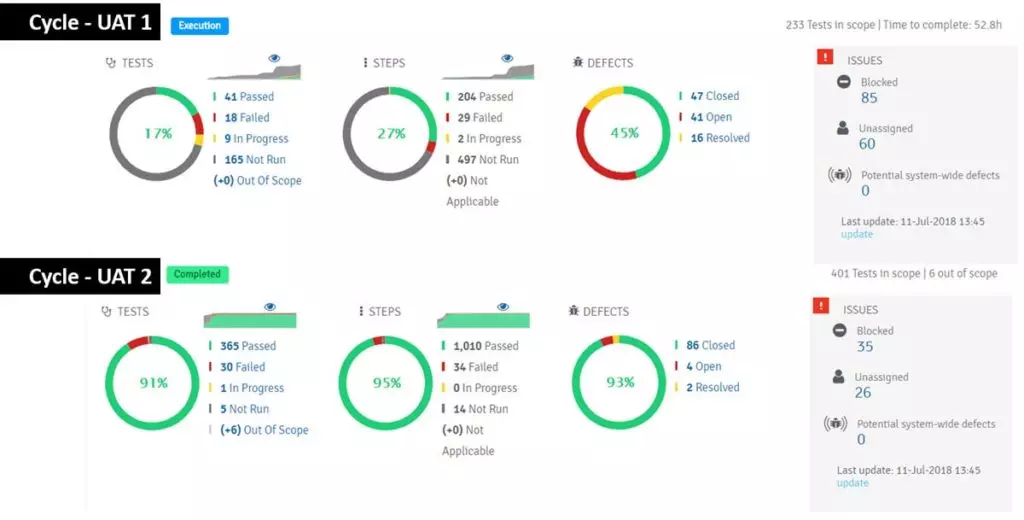

How Panaya Simplifies the UAT Testing Process
Does all of this sound complicated? It doesn’t have to be. A smart test management solution will help simplify your UAT cycles. Panaya Test Dynamix, our top-ranked end-to-end test management platform, includes features like test notifications, collaborative communications, automated documentation, and simple defect reporting. It allows end-users to quickly complete their part in the UAT cycle and return to business. The result is greater adoption, better ROI, fewer bottlenecks, real-time visibility, and zero risk at go-live. As an end-to-end testing solution that mirrors actual business processes, Panaya Test Dynamix provides those benefits and more, streamlining UAT and accelerating business process testing by 85%.
User acceptance testing need no longer be a battle. Download the eBook How to Simplify UAT Testing and learn how to:
- Automate more elements in your user acceptance testing
- Incentivize key testers with ease-of-use
- Gain business users’ confidence and promote adoption
Accelerate UAT Testing for All Stakeholders
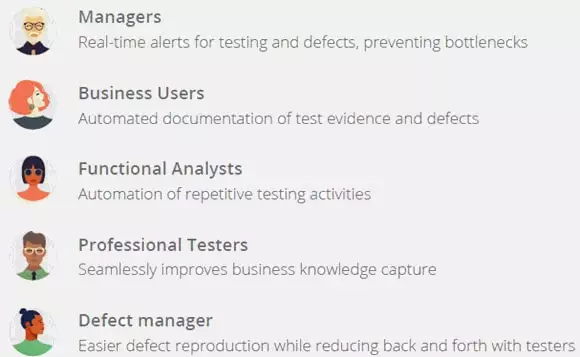
“We loved Panaya for its collaboration features. It is a user friendly, cloud-based solution that offers easily repeatable test scenarios between similar projects. We would recommend it to any other organization running SAP.”
Pam Brown | Senior Director, ERP Business Process Organization, Bruker

Key Takeaways
- UAT is a crucial final stage in the software development lifecycle, ensuring the software meets real-world business requirements.
- Proper planning and scoping are essential to a successful UAT process.
- Effective UAT requires coordination between technical teams and end-users, and overcoming challenges like dispersed teams and outdated tools.
- Best practices include gathering knowledge, scoping correctly, designing, executing, and confirming business objectives.
- Comprehensive documentation is vital for current and future UAT processes.
- Automating documentation and defect management can significantly enhance UAT efficiency.
- Tools like Panaya Test Dynamix can simplify UAT, providing real-time visibility, better ROI, and streamlined testing processes.
User Acceptance Testing – Simplified
Help business users make acceptance testing a priority by simplifying it. Gain user adoption and execute faster and safer UAT cycles.
Frequently Asked Questions
